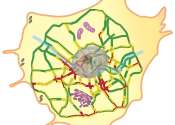Visualizing 'traffic jams' inside living cells
Researchers at the IBS Center for Molecular Spectroscopy and Dynamics (IBS CMSD), led by Director Cho Minhaeng and Professor Hong Seok-Cheol, have unveiled a revolutionary label-free microscopy technique—the Cargo-Localization ...









